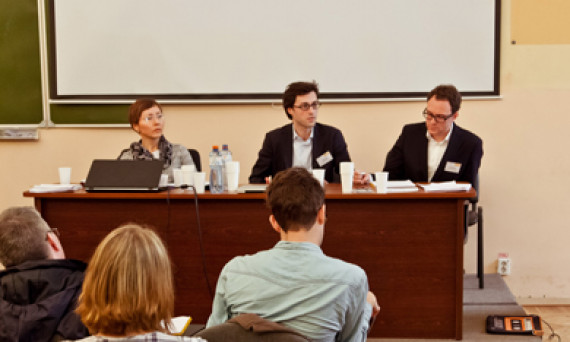On April 25-26 an international conference titled “After Stalin: The Late Soviet Personality” took place in EUSP. The conference brought together historians involved in research of Soviet subjectivity in various fields, including well-known experts like Anna Krylova, Susan Reed, Igal Halfin, Jochen Hellbeck, Benjamin Nathans, and Oleg Kharkhordin.
Three sections took place on the first day of the conference. These were devoted to the continuity and difference between the Stalin and Khrushchev periods (Anna Krylova, Anatoly Pinsky, Alexei Tikhomirov), living space and interpersonal relationships (Susan Reed, Darya Bocharnikova, Maria Maiofis, Anna Fishzon), as well as work and labor organizations in the late USSR (Galina Orlova, Yuri Zaretsky, Andrei Shcherbenok, Oleg Liebovich).
The second day of the conference was also divided in three sections: subjectivity in film and literature (Polly Jones, Mikhail Rozhansky, Ilya Kukulin, Cynthia Hooper), dissident movements (Juliane Fürst, Benjamin Nathans, Lev Krylenkov, Bella Ostromoukhova) and subjectivity in the Soviet regions (Sergey Abashin, Mark Lipovetsky, Aleksei Golubev, Artemy Kalinovsky).
On the first day of the conference, professor Alexei Yurchak (Department of Anthropology at the University of California, Berkeley) gave a keynote speech that addressed the Soviet experience as a fracture of consciousness. He also gave a genealogy of the concept of “subjectivity” and discussed the concept of displaced publics in the late USSR.
At the beginning of his report, Yurchak stressed the importance of an outside perspective on the late Soviet period and the reasons for the collapse of the Soviet Union. Post factum, it became clear that the “stagnation” era was not completely static, but rather a period of slow changes. While for most researchers the main objective is to search for one crucial factor in the disintegration of the USSR, Yurchak stressed the importance of not just the complexity, but also the randomness, the coincidence. Here he appealed to the the sociologist N. Luman, who considers chance to be a possible but not unavoidable event. As such, the collapse of the Soviet Union was a radical phenomenon that led to the spasmodic transformation of the system, moving it from one state to another. Such phenomena can be understood only later when the transition period is over and the revolutionary change has concluded. For Yurchak, however, the main research interest is not in the reasons for thich change, but rather perceptions of it both internal and external to the system. Why was the end of the Soviet system percieved as a completely unexpected event for which Soviet citizens were strangely prepared? Yurchak explains this preparedness by the fact that during perestroika, Soviet citizens experienced a fracture of consciousness. If we use Michel Foucault’s classification, this can be described as metanoia—an abrupt change as opposed to an epistrophe—gradually changing the self. The experience of mental revolution provided them with a kind of “critical glasses,” and the possibility to consider their own past and present differently. Thus, after perestroika and the collapse of the Soviet Union, citizens who had experienced a fractured world view suddenly perceived as completely natural that which a few years before had seemed impossible.
Yurchak also briefly presented the geneaology of the concepts of subject and subjectivity in the European tradition, stressing the complexity of these terms and the necessity of considering them anthropologically. Understanding the subject ast the transcendental I, the self, is opposed to the understanding of subjectivity as an historically conditioned phenomenon. The transcendental subject became the object of anthropological criticism in the second half of the 20th century. The subject as a discrete independent unit—an individual—is not a universal category but rather a cultural-historical modality. In contrast to the indivisible individual self, anthropology produced, in the 1980s, the concept of the dividual—the divisible self represented as a set of parts, each of which can be changed without changing the others. The dividual is socio-centric, a heteronomous object that fulfills external cultural scenarios. The individual and dividual are not opposite, but can be combined in one subject and coexist, complementing one another.
In research on the totalitarian school, the Soviet subject is the dividual, completely suboordinated to society. In post-totalitarian tradition, on the other hand, the Soviet subject is presented as transcendental. He is a pretender, wearing masks, resisting the totalitiarian regime, hiding and keeping himself indivisible. Now, however, both this and the other model seem too narrow. Following Charles Taylor, Soviet subjectivity should be represented as “porous,” that is neither static nor closed, but joining features of the dividual and the individual.
Yuchak stressed that there is still one place open to criticism. Researchers on subjectivity still refer to the actor, whom they consider to be an individual person, ignoring the linguistic and intersubjective dimension of subjectivity. Here he considered the notion of the public in M. Warner’s interpretation. He characterizes the public as self-organized, long lasting, opening and plural groups. These are formed of individuals who recongnize themselves as the addressees of appeals but never fully coincide with the public that sends the message. Soviet citizens were the recipients of a multiplicity of discourses, most of them ideological. They responded, however, not to the content of the appeals but their form. The fact that a person at a demonstration cried “hurrah!” in response to a slogan did not mean that he supported the slogan. According to Yurchak, Soviet demonstrators as well as voters at Party meetings and many others regonized themselves as part of the public of a particular discourse and reacted appropriately, thus maintaining the form of the communication process without delving into its contents. In this sense, “displaced” publics appeared in the late Soviet period—that is, publics in which form dominated over content. The late Soviet personality was formed inside of these publics, and it is this supraindividual specificity that researchers should take into account in studying issues of Soviet subjectivity.
Olga Yakushenko



































